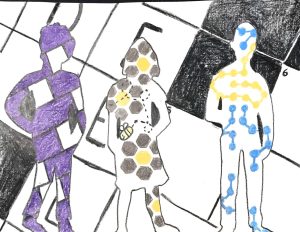The Matrix: An Ode to 1999
March 13, 2023
You wake up submerged in a capsule filled with a gooey substance. You gasp for air and break out from the capsule, only to see rows upon rows of others asleep in their own identical capsules. You’re sucked down a pipe and met with a group that takes out the wires attaching you to your pod and cleans you up. You’ve chosen the red pill.
It’s no secret that The Matrix is one of the most famous sci-fi films in history. But no one talks about how intrinsically 1999 the film was, or the parallels it drew to the turn of the century through a harmonious blend of 1990’s grunge music, overly exposed shots, and revolutionary special effects that would become some of the most iconic and overused tactics in action. The film follows the path of a young man (Keanu Reeves), who goes by the name Neo online, and his breaking out of the matrix. A gross simplification of the concept is as follows: that reality as society knows it is a programmed simulation. Neo has the opportunity to take a red pill and break out, or take a blue one and forget he knew anything about the simulation. I’ll let you guess which one he took.
The film doesn’t waste a moment in jumping straight to the intricate fight sequences, as its opening scene is its most cutting-edge. The femme fatale lead, Trinity (Carrie-Anne Moss), is sitting in a chair trapped by a row of police officers coming to arrest her. She slowly stands with her hands up, before performing a combination designed to kill. Directors Lana and Lilly Wachowski freeze Trinity in mid-air as she pounces, arching her back and raising her hands in front of her. The camera does a 360 of her frozen figure; this is when everyone in the movie theater gasps at the sight of new-age technology. In combination with a latex black bodysuit and the movie’s green-tinted filter, this scene singlehandedly embodies what it meant to be a futuristic super spy with an agenda.
In keeping with futurism, the “real world” Neo wakes up in is set in the year 2199, one thousand years after the film was released. Their interpretation of the dystopian 22nd century included baggy, grayish-beige clothing with chunky strap-on boots over their pants. This exaggeration of the apocalyptic future was, at the time, synonymous with the fear of hitting the year 2000. The film was generally striving for oneness, the chance to revolutionize filmmaking just in time for the 21st century.
From the metal soundtrack—featuring voices such as Marylin Manson and Deftones—to its bright, headache-inducing shots, The Matrix was the epitome of a 1990s attempt at depicting the world over the next two centuries. So whether the movie is a time capsule for fans to revisit, a conspiracy with a cult following, or the truth hiding in plain sight, I urge you to ask yourself: Blue pill? Or red pill?









